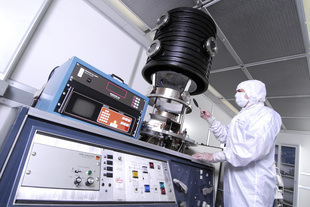Nov 27 2007
A 1957 classic sits in the Georgia Tech Research Institute (GTRI) clean room. It’s not a Chevy, but a Veeco vacuum evaporator more than six feet tall and five feet wide.
 Carefully maintained and updated, a 50-year-old vacuum evaporator is still applying coatings in a Georgia Tech Research Institute (GTRI) clean room.
Carefully maintained and updated, a 50-year-old vacuum evaporator is still applying coatings in a Georgia Tech Research Institute (GTRI) clean room.
The evaporator, still in use today, deposits thin films necessary for microfabrication processes. Applications include creating the reflective or anti-reflective coatings on optics and building up layers of insulators, semiconductors and conductors to form integrated electronic circuits.
“It’s a very rugged machine and it’s gotten better with age,” says Mike Harris, a principal research engineer in GTRI's Electro-Optical Systems Laboratory. Harris first used the Model 775 evaporator in 1972 as a student.
The system operates by evaporating a source material, such as a metal, in a high vacuum, allowing vapor particles to travel directly to a target object, such as a semiconductor, where they condense back to a solid state and form a thin film of the source material.
Harris attributes the machine’s longevity to its design and documentation – and to the skills of GTRI technicians and engineers. “The operator and maintenance manuals are excellent, with exploded views of the various piece parts, making it very easy for our technicians and engineers to repair it when we have problems,” he explains.
In addition to repairing the system, GTRI engineers have upgraded and modified the evaporator several times since it was purchased.
First, they changed the high vacuum pump from a diffusion pump to a more modern cryogenic pump in 2002. The diffusion pump generated a high speed jet of vapor by boiling fluid and directing the vapor in the pump throat down into the bottom of the pump and out the exhaust. The newer cryogenic pump traps gases and vapors by condensing them on a cold surface.
To increase the uniformity of results, GTRI researchers added a planetary substrate fixture that rotates inside the evaporation chamber.
In addition, the original system was designed with a tungsten filament that was heated to a high enough temperature so that the source material placed in a crucible on the filament evaporated. GTRI engineers changed this to an electron beam evaporator that fires a high-energy beam from an electron gun to boil a small spot of material, allowing lower vapor pressure materials to be deposited.
Since the 1957 system still runs and remains optimal for numerous applications, Harris sees no reason to buy a new one. “New systems like this probably cost between $700,000 and $1 million,” he adds. “And the new systems are designed primarily for throughput and that’s not necessarily best for a research environment.”